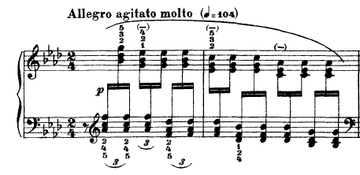Transcendental Etude No. 10 (Liszt)
- Transcendental Etude No. 10 (Liszt)
-

The first two bars of the Transcendental Etude No.
10
Transcendental Etude No. 10 in F minor, "Allegro agitato molto" is the tenth Transcendental Etude of a set of twelve by Franz Liszt. It is possibly the most played of the etudes and has a prominent melody.
Passage work for the left hand is rather difficult, while the right hand plays the melody mostly in octaves. There are several portions where the left and right hands alternate to play descending chords reminiscent of a sigh. Other difficulties include cramped spacing (the hands are often close together), left-hand arpeggiated passage work, and the right hand ascending the keyboard in swiftness using only the thumb, the third, and fourth finger. Musically, it is a study in pushing melodic lines to the razor's edge with passion and dramaticism while maintaining the melody. The climax occurs right after the softest part of the piece and is an octave D-flat played 23 times in a row with rhythmic changes and rapid left-hand arpeggios that constantly change theme.
This is one of the more popular etudes of the set, and, while difficult, it is not considered to be one of the hardest.
It is in sonata form, with a second group in E-flat Minor, and an explosive coda. The 1838 version bears a coda which is modelled after the coda in the finale of Beethoven's Opus 57 Appassionata.
External links
Wikimedia Foundation.
2010.
Look at other dictionaries:
Transcendental Etude No. 8 (Liszt) — Transcendental Etude No. 8 in C minor Wilde Jagd (Wild Hunt) is the eighth etude in the twelve Transcendental Etudes by Franz Liszt. It requires exceptional endurance and rigorous technical elements. Strong, supple wrists are required in order to … Wikipedia
Transcendental Etude No. 11 (Liszt) — Transcendental Etude No. 11 in D flat, Harmonies du Soir is the eleventh etude of the set of twelve Transcendental Etudes by Franz Liszt. This etude is a study in harmonies, broken chords played in quick succession, full octave jumps, chromatic… … Wikipedia
Transcendental Etude No. 12 (Liszt) — Transcendental Etude No. 12 in B flat minor is an étude for piano written by composer Franz Liszt. It has the programmatic title Chasse Neige , ( impetuous winds which raise whirls of snow ) and is the 12th and last of the Transcendental Etudes.… … Wikipedia
Transcendental Etude No. 5 (Liszt) — Transcendental Etude No. 5 in B flat Feux Follets (Will o the Wisp) is the fifth etude of the set of twelve Transcendental Etudes by Franz Liszt. Difficulties As with the other works in the Etudes , Feux Follets is considered one of the most… … Wikipedia
Transcendental Etude No. 3 (Liszt) — Transcendental Etude No. 3 in F, Paysage (Landscape), is the third of twelve Transcendental Etudes by Franz Liszt. It is generally considered to be one of the easier studies.The piece suggests a peaceful country scene; the first section is played … Wikipedia
Transcendental Etude No. 1 (Liszt) — The opening bar of the Transcendental Etude No. 1 Transcendental Etude No. 1 in C Preludio is the first of twelve Transcendental Etudes by Franz Liszt. It is a short piece which can be played in less than a minute at concert speed. Form Octaved… … Wikipedia
Transcendental Etude No. 9 (Liszt) — The first two bars of the Transcendental Etude No. 9 Etude No. 9 in A flat, Ricordanza is the ninth of the twelve Transcendental Etudes by Franz Liszt. It has wild but gentle cadenzas and demands delicate finger work. There are some areas with… … Wikipedia
Transcendental Etude No. 7 (Liszt) — The first two bars of the Transcendental Etude No. 7 Transcendental Etude No. 7 in E flat, Eroica is the seventh of the twelve Transcendental Etudes by Franz Liszt. It is a study of rapid downward runs, bravura and octaves (at the end). In a… … Wikipedia
Transcendental Etude No. 2 (Liszt) — The first deceptively simple bars of the Transcendental Etude No. 2 Transcendental Etude No. 2 in A minor, Molto Vivace , or Fusées (French: “Rockets”) is the 2nd piece of the Transcendental Etudes by Franz Liszt. The title Fusées is not Liszt s… … Wikipedia
Transcendental Etude No. 6 (Liszt) — The first bar of the Transcendental Etude No. 6 Franz Liszt s Transcendental Etude No. 6 in G minor Vision is the sixth of his twelve Transcendental Etudes. It is a study of the extensions of the hand, hands moving in opposite directions,… … Wikipedia

